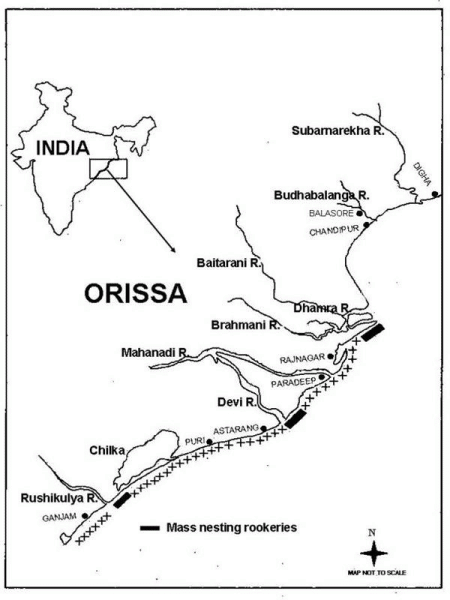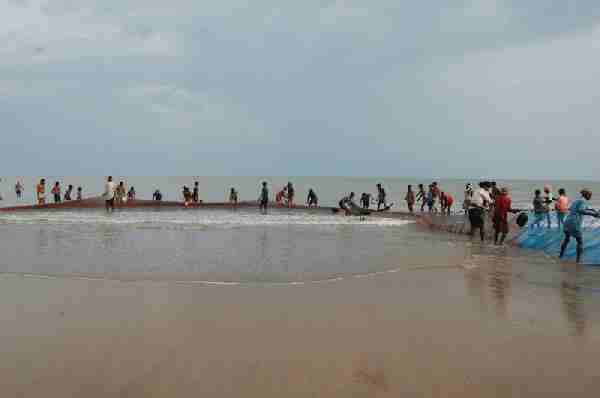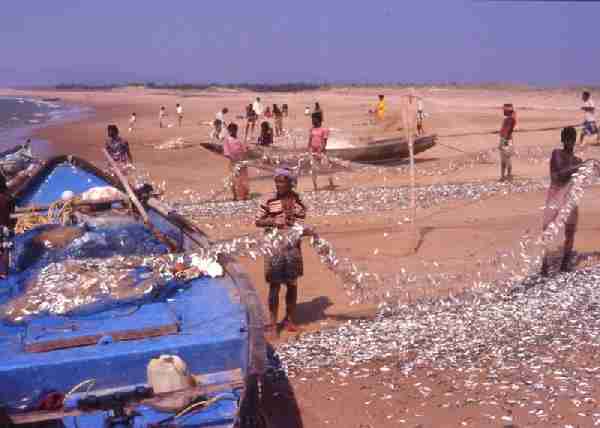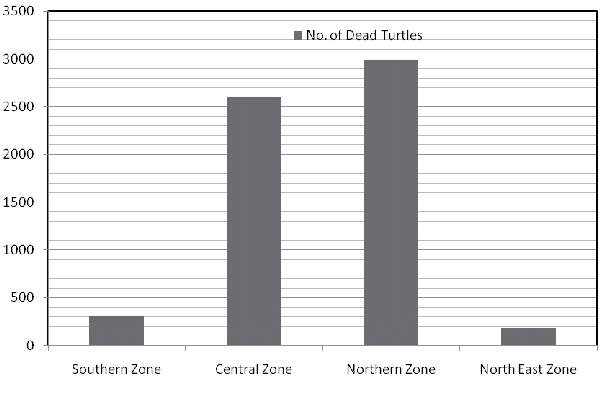Basudev Tripathy
Rushikulya Sea Turtle Protection Committee, Purunabandha, PO. Palibandha, Dist. Ganjam –761 021, Orissa, India.
Address for correspondence: Wildlife Institute of India, Post Box # 18, Chandrabani, Dehradun – 248 001, Uttaranchal, India.
E-mail: tripathyb{at}yahoo.co.uk; tripathyb{at}gmail.com
Introduction
Of the seven species of the world’s marine turtles, four species are known to occur and nest along the coastal stretch of India (Shanker & Choudhury, 2006). The Orissa coast on the east is known globally for the annual olive ridley turtle (Lepidochelys olivacea) ‘arribada’ event. World populations of olive ridleys are dwindling (National Research Council Report, 1990) and, at many major breeding rookeries, they are facing numerous problems. The challenges that olive ridleys face from human activities impact on every stage of their life cycle, from loss of nesting beach and foraging habitats to mortalities in coastal waters.
In India, despite being listed in Schedule I of the Indian Wildlife (Protection) Act, 1972, and Appendix I of CITES and CMS (Appendices I & II), olive ridleys have suffered heavy recent casualties. Between 1990 and 1999, more than 1,000,000 dead olive ridleys have been washed ashore along the Orissa coast alone (Pandav and Choudhury, 2000); this is an alarming situation for the species.
Considering the threats to this endangered species in Orissa, the honourable Supreme Court of India constituted a Central Empowerment Committee (CEC) that has issued directives and recommended that the state of Orissa should take stringent measures for onshore and offshore protection of olive ridleys along the Orissa coast (CEC Interim Directions 2003 & CEC Site Visit Report 2004; see also Tripathy, 2005). Any protection measure should result in a decrease in the number of dead turtles along the coast. The state officials claim to have taken several protection measures to safeguard the olive ridleys in Orissa’s coastal waters, including incidental fishery-related mortality of turtles. However, since 1999 (Pandav, 2000), information on the number of dead turtles washed ashore along the Orissa coast has been unavailable. There is also no information on the size classes of turtles that are dying every year along this coast. This information is essential to ascertain whether older populations are still arriving for arribadas in Orissa. The present paper describes the current situation of spatio-temporal turtle mortality along the Orissa coast during the ridley breeding season.
Study area
Orissa in India is one of the four maritime states bordering the Bay of Bengal (Fig. 1). The state has a coastline of about 480km (8% of the Indian coastline).
Fig. 1. Map of Orissa coast showing major rivers and olive ridley sea turtle mass nesting rookeries.
There are seven coastal districts, namely Ganjam, Puri, Khurda, Jagatsighpur, Kendrapara, Bhadrakh and Balasore, including approximately 641 coastal fishing villages (CMFRI, 2006). Intensive mechanized fishing takes place all along the coast during the post-monsoon (September-October) and winter (December-February). While the coastal stretch between the Subarnarekha and Dhamra river mouths is predominantly composed of mudflats with stunted mangroves, the coastal stretch between the Dhamra and Mahandi river mouths has sandy beaches and deltaic mudflats with mangroves; in certain beaches olive ridleys nest solitarily or en masse.
Methodology
The fieldwork was carried out between December 2008 and May 2009, which is reported to be the breeding season for olive ridleys along the Orissa coast (Dash & Kar, 1990; Pandav et al., 1994). A general profile of fishing and fishermen along the Orissa coast was prepared through secondary sources of information gathered from Central and State Fisheries Agencies. For dead turtle counting, the coastal stretches were visited once a month on foot or with a bicycle/motorcycle, wherever approachable. For a systematic survey, the entire stretch of 480-km Orissa coast was divided into four zones, viz. North-east (Udayapur – Dhamra), North (Dhamra – Devi), Central (Devi – Chilka) and South (Chilka – Sonapur). However, the total carcass count was made along selected beaches, viz. Gahirmatha (35km); Paradeep (15km); Kujang (10km) and Devi (20km), where heavy mortality has been recorded over the last decade (see Pandav & Choudhury, 2000).
Curved carapace length (CCL) in cm, sex (using external characteristics) and apparent cause of death were recorded wherever possible (following Bolten, 1999). Males were characterized by the presence of a long tail, which extends much beyond the posterior end of the carapace, and the strongly curved claw on the fore flipper. In the case of decomposed turtles, this claw characteristic was used to determine the sex. Highly decomposed specimens with no visible external characteristics were classified as turtles of unknown sex. During this survey, local people were interviewed for any secondary information on the possible cause of turtle mortality, the kind of craft and gear used, turtle aggregation and fishing practices in their localities.
Results and Discussion
Orissa has a long coastline, yet the intensity of traditional marine fishing activities by local communities is low. Instead, fishing is dominated by migrating fishermen from West Bengal (between the West Bengal-Orissa borders and Paradeep) and Andhra Pradesh (from Konark to the Orissa-Andhra Pradesh border). From the information gathered during the present study, mechanized fishing along the Orissa coast is characterized by trawl and gill-net fishing, and trawlers from Andhra Pradesh often come and fish along the southern Orissa coast. However, unlike the northern Orissa coast, the majority of coastal dwellers along the southern Orissa coast are Nolias – artisanal fishermen migrated from Andhra Pradesh, engaged in seagoing or estuarine fishing. Among the different types of fishing gear (Figs 2-4), drift/gill-nets are most popular and monofilament nets are abundantly used. However, after the introduction of the BOBP (Bay of Bengal Programme) in 1990, many of the wooden catamarans are now converted into fibreglass BLCs (Beach Landing Craft) along the south Orissa coast (Table 1).
| Approximate coastline length | 480km |
Continental shelf area
| 26,000km2
|
No. of fishing villages
| 641
|
No. of fishermen families
| 86,352
|
No. of landing centres
| 63
|
No. of fishing craft:
|
i. Trawlers
| 1,340
|
ii. Purse seiners
| 22
|
iii. Gill-netters
| 1,760
|
iv. Dolnetters
| 254
|
v. Liners
| 28
|
vi. Others
| 173
|
Total Mechanized (Trawlers & gill-netters) *
| 3,577
|
Motorized (BLC) #
| 4,719
|
Non-motorized (country boats) $
| 15,444
|
Total
| 23,740
|
* Trawlers and gill-netters are fishing vessels where nets are operated mechanically.
# Motorized fishing vessels are powered by outboard motors and are beach landing crafts from which nets are operated manually.
$ Non-motorized fishing vessels are country boats in which nets are operated manually.
Table 1. Marine fishing and fishermen of Orissa. Source: CMFRI, Cochin. 2006
Fig. 2. Traditional shore seine fishing along the north-east coast of Orissa.
Fig. 3. Mechanized and motorized fishing boats used on the northern and central Orissa coast.
Fig. 4. Fishing practice along the southern Orissa coast with traditional craft using monofilament nets.
Fig. 5. Turtle mortality in different zones surveyed along the Orissa Coast
Although the number of mechanized boats operating from the north-east zone is the highest among all zones of Orissa, the lowest ridley mortality probably reflects the absence of sea turtle nesting beaches, since the area is characterized by wide muddy intertidal zones and hence features a lower number of turtles in the neighbouring coastal waters . Details of the monthly count of dead turtles along different zones are presented in Table 2. There was an extremely significant difference between the numbers of males and females stranded along the coast during different months (Chi-square test: X2= 1.4614, df = 5, p = 0.0002), with far more females being stranded than males. The excess of females could have several causes. First, female sea turtles can store sperm to fertilize several egg clutches (olive ridleys lay 1-3). This means that they ‘run the gauntlet’ of coastal fishing gear to lay their eggs more often than do males. In addition, there is good evidence that a proportion of ridleys mate far from the breeding beaches (National Marine Fisheries Service and U.S. Fish and Wildlife Service, 1998), so male mortality is rather less likely to be expressed in the breeding areas. Second, there is evidence that global warming may be creating inherent female biases in most sea turtle populations.
| Month | Nov | Dec | Jan | Feb | Mar | Apr | May |
|---|
| Zone | M | F | M | F | M | F | M | F | M | F | M | F | M | F |
North-East
| 0
| 1
| 2
| 28
| 7
| 46
| 0
| 53
| 0
| 36
| 0
| 5
| 0
| 0
|
Northern
| 24 | 68 | 365 | 457 | 331 | 684 | 291 | 659 | 18 | 54 | 6 | 32 | 0 | 0 |
| Central | 24 | 75 | 418 | 657 | 326 | 389 | 128 | 487 | 16 | 66 | 0 | 13 | 0 | 0 |
| Southern | 0 | 0 | 5 | 26 | 83 | 174 | 3 | 20 | 0 | 0 | 0 | 0 | 0 | 0 |
| Total | 48 | 144 | 790 | 1168 | 747 | 1293 | 422 | 1219 | 34 | 156 | 6 | 50 | 0 | 0 |
Table 2. Monthly count of dead turtles in different zones of Orissa. (M=Male, F=Female)
Among the three known mass nesting stretches along the Orissa coast (Gahirmatha, Devi and Rushikulya), 27.4 % of mortality (1667) occurred in the 35-km stretch of Gahirmatha coast. The coastal waters of Gahirmatha and adjacent areas are relatively shallow and are mating grounds of olive ridleys. The coexistence of large numbers of turtles with heavy trawling near the shore from fishing bases viz. Kashaphali, Balaramgadi, Dhamra and Talchua is likely to have resulted in high turtle mortality. Dead turtles were also observed along the Devi coast. The total number of deaths along the 17-km Devi coastal stretch was 1458 (23.9 %). However, far fewer dead turtles were found along the coast between Rushikulya and Gopalpur (n=11; 0.18 %) (Fig. 6). The reason for this could be due to different fishing practices in the region (traditional fishing by monofilament nets and country boats) unlike the north-east coast where mechanized fishing is predominant.
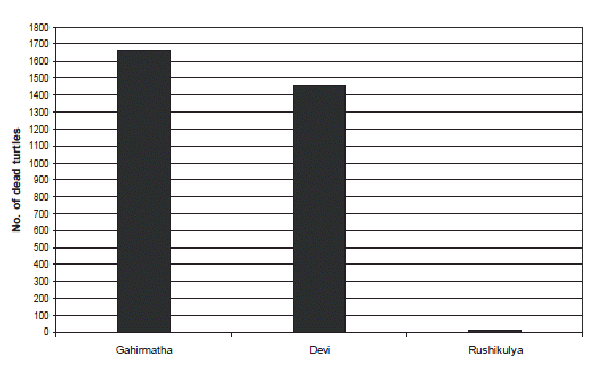
Fig. 6. Olive ridley turtle mortality recorded along the mass nesting rookeries of Orissa.
All the turtles counted during the study were adults and the mean CCL ± S.D. for dead females and males counted were 67.6 ± 2.5cm (range = 55.0 - 77.8cm, n = 560) and 67.0 ± 2.8cm (range = 51.8 - 76.7, n = 455) respectively. The number of dead turtles along the Orissa coast was found to have increased from the last week of December, reached a peak during February and been low in April. The frequent observations of large scale entanglement of olive ridleys in fishing gear supports the argument that mechanized fishing is indeed the major reason behind this large scale mortality. Once entangled, turtles die from suffocation or are beaten to death by boatmen for easy removal from the net (personal observation). The injuries on heads and carapaces of turtles washed ashore also provided ample evidence of this fact.
The high mortality of olive ridleys in Orissa is a cause for serious concern as the Kemp’s ridley population faced a similar problem in the past (Pritchard, 1997) and what is more alarming is the fact that the majority of turtles washed ashore are adult breeding individuals with a high reproductive value to the population. While it is true that no conservation effort can be successful without adequate protection at all stages in the life cycle of a sea turtle, the analyses of Crouse et al. (1987) strongly suggest that efforts to reduce mortality of adult turtles will be much more effective at promoting population growth than efforts to increase the number of hatchlings leaving the beaches.
Studies suggest that the numbers of dead turtles washed ashore represent a minimum estimate of mortality (Hillestead et al., 1982; Murphy & Hopkins-Murphy, 1989). In the context of Orissa, in recent years, the Wildlife Wing of the Orissa Forest Department has adopted the practice of burying dead turtles immediately upon being washed ashore. The CEC has strongly discouraged this practice, but the State Government continues to bury dead turtles at important beaches, giving as a reason that there are potential risks of animal/human diseases if putrefied carcasses are left on the beach. When the State Wildlife Authority enumerates turtle mortality along the Orissa coast, it is not known whether these buried turtles are accounted for, so the number of turtles killed could actually be much higher than the figure reported here.
Conservation requirements and suggestions
Turtle mortality due to incidental capture in fishing nets in Orissa has been reported since the 1970s. Most published papers and reports state that gill-nets and trawl-nets are responsible for the death of turtles by drowning. It has also been reported that gear used by traditional non-mechanized craft causes entanglement. Therefore, the first step required is strict enforcement of a ban on near-shore mechanized fishing and commercial fishing activities in areas of high sea turtle aggregation. The restrictions required on various kind of fishing craft and gear in areas where turtles congregate are given in Table 3.
Table 3. Recommendations on the restrictions required on various kinds of fishing craft and gear in turtle aggregation areas in Orissa.
Type of vessel
| Detail
| Area
| Distance
| Time
|
|---|
Trawler
| Large | Entire Coast | 10km
| Year Round
|
| | Small | Entire Coast | 5km | Year Round |
| | | NFZ | 10km | Nov - April |
| IBM Gill-netter | Multifilament
| Entire Coast
| 5km | Year Round |
| | | NFZ | 10km | Nov - April |
IBM Gill-netter
| Monofilament | NFZ | 10km | Nov - April |
| OBM Gill-netter | > 15 HP engine | NFZ | 10km | Nov - April |
| OBM Gill-netter | < 15 HP engine | NFZ | 5 km | Mass Nesting |
| No motorisation | | NFZ | 5km | Mass Nesting |
IBM – Inboard Motor Engine; OBM – Outboard Motor Engine; NFZ – No Fishing Zones near mass nesting beaches (Gahirmatha, Devi River mouth, Rushikulya) to be monitored and defined during nesting season. Approximating 20km of coast.
Undoubtedly, the coastal waters along this stretch support high sea turtle populations. The coastal waters of Gahirmatha were declared a Marine Sanctuary in 1997 under the Wildlife (Protection) Act, 1972, of the Government of India and thereby fishing of no kind is allowed inside the sanctuary at any time of year. The Government of Orissa (Department of Fisheries) has issued orders under the Orissa Marine Fisheries (Regulation) Act (OMFRA), 1984, that prohibit all kinds of fishing in the coastal waters of the Gahirmatha. Also there is a seasonal prohibition on near-shore fishing within 5km by motorized boat (January – May) and fishing by trawlers for a distance of 20km from the seashore at Devi and Rushikulya rookeries. However, the enforcement agencies, viz. the State Wildlife Department and the Fisheries Department, due to lack of infrastructure, are unable to enforce these various regulations. Therefore, the agencies concerned should be provided with adequate infrastructure for strict enforcement.
The use of Turtle Excluder Devices (TEDs) in trawl nets should be made mandatory for vessels operating in the coastal waters of Orissa. TEDs are essentially trapdoors which can be attached to trawl nets, and they allow large animals like sea turtles to escape from the net without significant loss of fish catch. However, use of TEDs alone will not bring down the turtle mortality because turtles are also caught and killed in gill-nets, and TEDs cannot be used in these. Therefore, a combined strategy including strict enforcement of the existing law on marine fishing should be adopted.
The Supreme Court-constituted CEC visited Orissa in 2003-4 to review the turtle conservation measures taken up by the State Government. The Committee was of the view that insufficient steps have been taken by the State Government for safeguarding the turtles. Henceforth, the directives given by CEC as well the judgement of the Orissa High Court need to be complied with by the State Government and their recommendations should be strictly followed.
The reproductive value of an adult turtle is much higher than any other life stage. Moreover, the fact that both male and female olive ridleys remigrate annually to the same breeding area where fishing intensity is high puts them at a greater risk of getting killed in the fishing nets. It is disturbing that more females than males are being killed as female adults are more valuable in terms of producing the next generation. Therefore, the high level of olive ridley mortality recorded during this study is a matter of utmost concern and needs to be addressed immediately.
Acknowledgements
This report was an outcome of the short term project supported by the British Chelonia Group. I am grateful to the BCG and to Anne Rowberry, Conservation Officer, for approving this project for funding. My sincere thanks are also due to Bob Langton, the previous BCG Conservation Officer, for all his advice and support. The author thanks John Davenport for his review and comments on the manuscript. Field Assistants, especially Rabi, Satya, Jaga, Bichi and Nirua, helped me throughout the field work in Orissa. And last but not least, I am thankful to the coastal communities, civil society members and fisherfolk along the Orissa coast for their help and support.
References
Bolten, A.B. (1999). Techniques for measuring sea turtles. In: Eckert, K.L., Bjorndal, K.A., Abrell-Grobois, F.A. & Donnelly, M. (eds). Research and management technique for conservation of sea turtles. IUCN Marine Turtle Specialist Group Publication No. 4, CGC, Blanchard, Pennsylvania, USA, pp. 110-114.
Central Empowered Committee (2003). Government of India, New Delhi. Interim Directions dated 7th March 2003, in the matter of Application No. 46.
Central Empowered Committee (2004). Government of India, New Delhi. Site visit report, February 2004.
CMFRI (2006). Marine Fisheries Census, 2005. Central Marine Fisheries Research Institute, Cochin.
Crouse, D.T., Crowder, L.B. & Caswell, H. (1987). A stage-based population model for loggerhead sea turtles towards the sea. Science 106: 398-399.
Dash, M.C. & Kar, C.S. (1990). The Turtle Paradise: An Ecological Analysis and Conservation Strategy. Interprint. New Delhi.
Frazer, N.B. (1987). Preliminary estimates of survivorship for wild loggerhead sea turtles, Caretta caretta. Herpetologica 21: 232-235.
Hillestead, H.O., Richardson, J.I., Mcvea, C., Jr. & Watson, J.M., Jr. (1982). Worldwide incidental capture of sea turtle. In: Bjorndal, K.A. (ed.). Biology and conservation of sea turtles. Second edition. Washington, DC: Smithsonian Institution Press, pp. 489-497.
Murphy, T.M. & Hopkins-Murphy, S.R. (1989). Sea Turtle and Shrimp Fishing Interactions: A Summary and Critique of Relevant Information. Washington, DC: Center for Marine Conservation, 52 pp.
National Research Council (NRC) (1990). Decline of the Sea Turtles: Causes and Prevention. National Academy Press, Washington DC.
National Marine Fisheries Service and U.S. Fish and Wildlife Service (1998). Recovery Plan for U.S. Pacific Populations of the Olive Ridley Turtle (Lepidochelys olivacea). National Marine Fisheries Service, Silver Spring, MD.
Pandav, B. & Choudhury, B.C. (2000). Conservation and management of olive ridley sea turtle (Lepidochelys olivacea) in Orissa. Final Report, Wildlife Institute of India.
Pandav, B., Choudhury, B.C. & Kar, C.S. (1994). A status survey of olive ridley sea turtle (Lepidochelys olivacea) and its nesting habitat along the Orissa coast, India. Wildlife Institute of India, Dehra Dun.
Pandav, B. (2000). Conservation and management of olive ridley sea turtle (Lepidochelys olivacea) in Orissa. Unpublished PhD Thesis, Utkal University, Orissa.
Pritchard, P.C.H. (1997). Evolution, Phylogeny and Current Status. In: Biology of sea turtles, Lutz, P.L. & Musick, J.A. (eds). CRC Marine Science Series.
Tripathy, B. (2005). A study on the ecology and conservation of olive ridley turtle (Lepidochelys olivacea) at the Rushikulya rookery of Orissa coast, India. Unpublished PhD Thesis, Andhra University, Visakhapatnam.
Testudo Volume Seven Number Two 2010
Top

